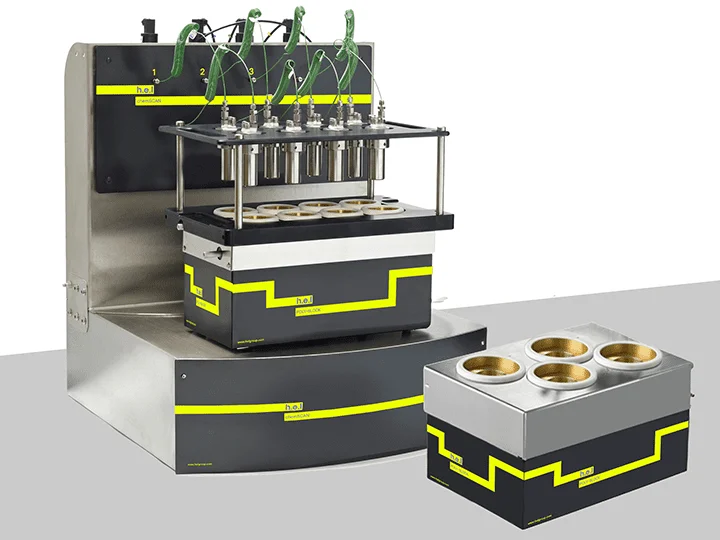
ChemSCAN
Parallel Catalyst Screening and Development Platform
Product Category: Catalysis and Hydrogenation
Industry: Batteries, Electrochemistry, Particle and surface science
Supplier: H.E.L. Group
Description
The ChemSCAN is a bench-top, automated parallel catalyst screening platform, designed for the rapid screening of high-pressure reactions and catalysts. The 4 reactor variant, supports reactors ranging from 16ml to 500ml. As with the fully automated ChemSCAN, each stirred reactor is independently controlled and monitored, allowing screening tests to be carried out concurrently and accelerating development time.
Reactor Options
High-Pressure Reactors are most commonly 16 mL in but this is now interchangeable with 30 and 50ml reactors, all stirred and with separate temperature control. For larger volumes, up to 400 mL, bigger modifications are needed. All feature efficient magnetic stirring the following being typical choices:
- Stainless Steel or Hastelloy wetted parts
- Suspended mechanical agitation for efficient mixing on small scale and no-viscous samples
- Overhead direct agitation for larger vessels (100 ml plus)
- Up to 200 bar
- Up to 250 ° C
Vessels to suit any scale…
16mL Vessels
16 mL Vessels available across the range, but specifically designed for chemistry screening on the HPCS unit. Each vessel is supplied with a multi-port lid and a central thermowell. The thermowell can be used to support suspended stirrers (PTFE, stainless, or Hastelloy) in order to improve mixing.
The small size is ideal for reducing chemical inventories for screening runs, and provide excellent data for selecting the chemical systems to proceed to larger-scale testing.
75, 160, 300 or 400 ml working volumes
Larger vessels ideal for High-Pressure Optimisation.
Reliable & scalable results can be obtained using suspended mechanical agitation. Suspended agitation provides a low-cost option without the chance of leaks. Where overhead motors are needed, the vessels can be supplied with magnetic rotating seals and conventional drives (75ml vessel not available with overhead agitation). This application can be extended by the inclusion of pressure measurement and control.
CAT systems
The multi reactor platforms, High-Pressure PolyBLOCK, High-Pressure ChemSCAN, High-Pressure AutoMATE, also accommodate HEL’s range of CATalyst screening system. These essentially manual multi-sample screening vessels have been designed to provide a simple easy-to-use tool for high-pressure reaction screening. They can be used directly in the zones of any HEL 4-pot reaction platforms, or on stirring hotplates and oil baths.
- 18 or 24 Samples
- 100 bar
- 4 ml working volumes
- Each vial independently agitated
CAT 18
Is designed to be used with 18 standard 2ml HPLC vials (with our without septa in place)
CAT 24
Is a simple device that allows the use of 24 open-top vials to be used at high pressure and temperature. Typical test volume is around 1ml. The vessels are refluxed with cold fingers that minimize solvent loss and cross-contamination.
Whitepapers
Publications
The following are a list of some technical publications which highlight the use of the equipment.
First Total Synthesis and Structural Confirmation of C13-Butylrubber Oligomers
Fabrizio Minicone Robin Attrill Michael Hodgson Katherine Wheelhouse Adrian Dobbs
01-May-2018
https://doi.org/10.1002/ejoc.201800496(Subscription or purchase maybe required for full access)
Production of Biomass-Based Automotive Lubricants by Reductive Etherification
Jadhav, Deepak Grippo, Adam M Shylesh, Sankaranarayanapillai Gokhale, Amit A Redshaw, John Bell, Alexis T
01-Apr-2017
https://doi.org/10.1002/cssc.201700427(Subscription or purchase maybe required for full access)
Quantitative Differences in Sulfur Poisoning Phenomena over Ruthenium and Palladium: An Attempt To Deconvolute Geometric and Electronic Poisoning Effects Using Model Catalysts
Amy Kolpin,† Glenn Jones,‡ Simon Jones,† Weiran Zheng,† James Cookson,‡ Andrew P. E. York,‡ Paul J. Collier,‡ and Shik Chi Edman Tsang*
01-Dec-2016
https://doi.org/10.1021/acscatal.6b02765(Subscription or purchase maybe required for full access)
Kinetics of hydrogenation and hydrogenolysis of 2,5-dimethylfuran over noble metals catalysts under mild conditions
Ying Lin Louie, Joseph Tang, Alexander M.L. Hell, Alexis T. Bell
01-Sep-2016
https://doi.org/10.1016/j.apcatb.2016.09.046(Subscription or purchase maybe required for full access)
Interstitial modification of palladium nanoparticles with boron atoms as a green catalyst for selective hydrogenation
Chun Wong Aaron Chan, Abdul Hanif Mahadi, Molly Meng-Jung Li, Elena Cristina Corbos, Chiu Tang, Glenn Jones, Winson Chun Hsin Kuo, James Cookson, Christopher Michael Brown, Peter Trenton Bishop & Shik Chi Edman Tsang
01-Dec-2014
https://doi.org/10.1038/ncomms6787(Subscription or purchase maybe required for full access)
Tuning the properties of PdAu bimetallic nanocatalysts for selective hydrogenation reactions
Elena C. Corbos*a, Peter R. Ellisa, James Cooksona, Valérie Brioisb, Timothy I. Hydea, Gopinathan Sankarc and Peter T. Bishop
01-May-2013
https://doi.org/10.1039/C3CY00255A(Subscription or purchase maybe required for full access)
Haloaurate and halopalladate imidazolium salts: structures, properties, and use as precursors for catalytic metal nanoparticles
Christopher J. Serpell‡ a, James Cookson b, Amber L. Thompson a, Christopher M. Brown b and Paul D. Beer
01-Nov-2012
https://doi.org/10.1039/C2DT31984E(Subscription or purchase maybe required for full access)
Etherification and reductive etherification of 5-(hydroxymethyl)furfural: 5-(alkoxymethyl)furfurals and 2,5-bis(alkoxymethyl)furans as potential bio-diesel candidates
Madhesan Balakrishnan, Eric R. Sacia and Alexis T. Bell
01-Mar-2012
https://doi.org/10.1039/C2GC35102A(Subscription or purchase maybe required for full access)
Development of Scaffold Synthesis for the Preparation of New Insulin-Like Growth Factor 1 Receptor Inhibitors
Ilaria Candiani, Germano D’Arasmo,* Franco Heidempergher, and Attilio Tomasi
01-Jan-2009
https://doi.org/10.1021/op8002536(Subscription or purchase maybe required for full access)
Brochures
Technical Literature
The following is a list of supporting Technical Literature.
Investigating Hydrogenations at Different Catalyst Loadings using the ChemSCAN
Testimonials
Testimonials
ChemSCAN

We are happy to confirm that HEL has supplied us with two high pressure reactor systems with automation. These systems are used for the screening of catalysts and/or different reaction conditions in hydrogenation and hydroformylation reactions. We have been using one device with eight autoclaves during the last 8 years or so, and we are very satisfied with it. The handling and programming is quite easy. The graphical evaluation of data allows us to get an overview about the process in each autoclave. The cooperation and service provided by the employees by phone or e-mail is plain sailing. It is for this reason that we bought a second HP ChemScan with four autoclaves in 2010 which was upgraded recently to an eight-autoclaves-device. It allows a larger variation of parameters and also the graphical evaluation of the results has been further improved.

This apparatus has many advantages. You have a good control of the temperature and pressure and you can follow the gas uptake on the monitor with good accuracy. The software is easy to use, with all commands for one run resumed in one program. The interface of the software is pleasant looking with a good view of all parameters. The reaction can be followed via the graphics, with the possibility of changing the scale of the graphs at any time. Reactors can be easily placed and removed. Handling the reaction mixtures before and after the reaction is quite simple.
University Joseph Fourier - France


